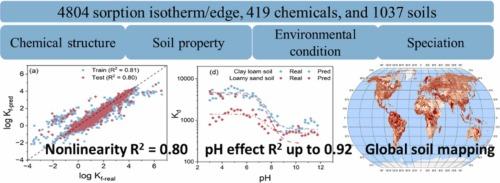Predicting Sorption of Diverse Organic Compounds in Soil-Water Systems: Meta-analysis, Machine Learning Modeling, and Global Soil Mapping
IF 12.2
1区 环境科学与生态学
Q1 ENGINEERING, ENVIRONMENTAL
引用次数: 0
Abstract
In recent decades, the environmental detection of various organic compounds (OCs) has highlighted the limitations of conventional soil-water sorption models, which simplify complex experimental conditions and often overlook OCs with polyfunctional and ionizable structures. To address these shortcomings, we compiled a comprehensive soil-water sorption dataset encompassing 20,945 data points for 419 OCs with various functional groups and 1037 different soils. Meta-analysis of the dataset revealed the trends of soil sorption associated with OC substructures, soil properties, and solution conditions. Machine learning models employing the XGBoost algorithm, in conjunction with MACCS fingerprints and experimental conditions, were developed to cover the entire spectrum of speciation for cationic, neutral, and anionic species. Among these, the individual models tailored to each speciation achieved an overall root-mean-square-error value of 0.32 for log Kd. Model interpretation revealed that the models correctly understood the contributions of various substructures, such as multiple aromatic rings and nitrogen or oxygen atoms, to sorption. The models were also found to accurately capture isotherm nonlinearity and the pH effect on the sorption of ionizable OCs. Finally, utilizing soil properties from the Harmonized World Soil Database, the models predicted the sorption of diverse OCs based on global soil properties under simulated environmental scenarios.

求助全文
约1分钟内获得全文
求助全文
来源期刊

Journal of Hazardous Materials
工程技术-工程:环境
CiteScore
25.40
自引率
5.90%
发文量
3059
审稿时长
58 days
期刊介绍:
The Journal of Hazardous Materials serves as a global platform for promoting cutting-edge research in the field of Environmental Science and Engineering. Our publication features a wide range of articles, including full-length research papers, review articles, and perspectives, with the aim of enhancing our understanding of the dangers and risks associated with various materials concerning public health and the environment. It is important to note that the term "environmental contaminants" refers specifically to substances that pose hazardous effects through contamination, while excluding those that do not have such impacts on the environment or human health. Moreover, we emphasize the distinction between wastes and hazardous materials in order to provide further clarity on the scope of the journal. We have a keen interest in exploring specific compounds and microbial agents that have adverse effects on the environment.
 求助内容:
求助内容: 应助结果提醒方式:
应助结果提醒方式:


